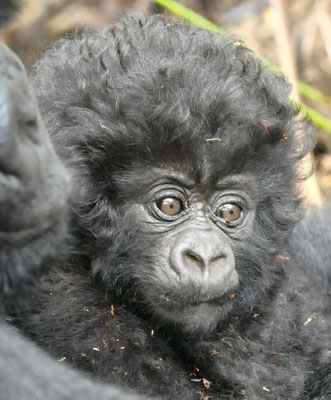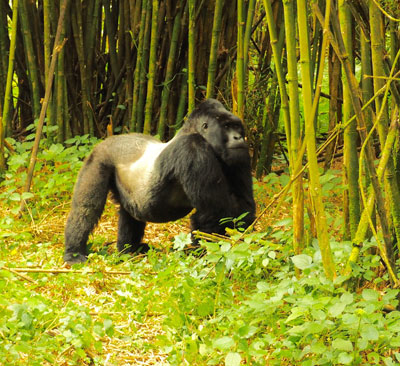Gorilla trekking in Rwanda
This item appears on page 30 of the July 2016 issue.
My daughter, Jill, and I traveled to Rwanda to see gorillas in the wild.
Our journey started at 10 p.m. on July 29, 2015, when we flew Qatar Airways out of New York to Doha, Qatar (hotel overnight), then to Entebbe, Uganda, and Kigali, Rwanda (March ’16, pg. 24).
Lex Hes, of South Africa-based Safari for Real (phone +27 082 922 9785, safariforreal.com), met us at the airport on Aug. 1 with our driver, Jeremiah Muhirea, who drove us a few hours away to the Mountain Gorilla View Lodge in northwestern Rwanda.
The lodge is in the foothills of Mount Karisimbi, one of the volcanic mountains that comprise the Virunga Massif, situated at the edges of Uganda and the Democratic Republic of Congo and including Rwanda’s Volcanoes National Park.
Ten habituated troops of mountain gorillas live in the park, and only 80 gorilla-viewing permits are issued daily, at $750 each. I would advise securing your permits before purchasing plane tickets.
I also think it’s wise to secure permits for two days. If you’re scheduled to visit gorillas only on one day and then there’s extremely bad weather or some other problem, you will not see them. It also maximizes this incredible experience. The rangers are very strict about allowing visits of only one hour, and the second time really is better.
The permits are expensive, but if you’re spending so much money on airfare anyway, two treks are in order. Chatting with other travelers, I noticed that those on less-expensive trips did only one gorilla trek. Of course, if the only way you can make the trip is to spend less money, then, by all means, go.
Early on the morning following our arrival, Jill and I took a drive to the park ranger station. This took only 10 minutes, a benefit of staying close to the station as opposed to staying in some of the other lodge/hotel options farther away.
The rangers generally have a good sense of where each gorilla family can be located on any given day. Trackers stay with their assigned gorilla troops until late afternoon, when the troops settle down for the night. (It’s amazing how the gorillas all make nests in the trees to sleep, even the large silverbacks.) The next morning, the trackers go back to locate them. Depending on how far up the mountain they are, some gorilla families are easier to get to than others.
Keeping in mind the anticipated walk or climb and the visitors’ physical abilities, the rangers assign permit holders to gorilla families. I am a senior who had double knee replacements in 2001 and a fix-up in 2014. It was very challenging for me, especially the first day, but, with help, I was able to do it.
Lex, Jill and I, along with a Canadian family of five, were assigned the Sabyinyo troop. After another quick drive to our starting point, we met our porters as well as a soldier and a ranger and each were offered a walking stick.
We climbed through potato fields for about 40 minutes to the park and then walked an hour and 45 minutes up through the brush, nettles and roots. The ranger sometimes used a machete to help us get through. We had been advised to take nettle-protecting gloves but ended up not needing them.
We climbed the brush-filled caldera and stopped to use our binoculars. There, in the trees, we spotted the gorillas. I was in awe.
Continuing, we caught up with the trackers who had found the troop that morning. We left our packs and walking sticks behind and, after walking a bit farther, found some of the Sabyinyo family members — a silverback, some females and youngsters. How exciting it was to be nearly nose to nose with them! We stood, mesmerized by how human-like their behaviors were.
We had been instructed on how to behave around the gorillas: don’t stare them down; act submissive if they appear upset or show aggression, and let them come to us. Lex helped me situate myself into an ideal position for taking pictures. He made sure we were getting the full experience.
The youngsters were playful, just like children at a playground.
One of the adult females was nudging the junior silverback to mate. He ignored her then all of a sudden took off behind the bushes and she followed surreptitiously.
A mom with a new baby sat next to another female who was cuddling her baby. Our presence didn’t seem to deter their behavior.
We walked a little farther and found youngsters playing among the vines. Before we knew it, our hour with the gorillas was over and we had to say good-bye.
The trek down another path took about 40 minutes, and it was another 30 to our van. Jill and I each gave our individual porter $20 for his service, and he was worth it. Lex took care of tipping the guides.
The following morning we went back to the ranger station for our next troop assignment. To reach the Kwitonda family, we drove to a different area and climbed 20 minutes to the edge of the park and then 40 minutes (not as steep as the day before) to the troop.
The members within family groups are close. A 7-week-old baby with curly hair was clearly loved. It was amazing to see how comfortable the gorillas were with human visitors. One of the younger gorillas kept playfully grabbing the pants of one of our group members.
After lunch, we drove about 1½ hours to the twin lakes and viewed the mountains from a different angle. We also passed the site where there is an annual ceremony to officially name the baby gorillas. It takes place in September and is attended by the president.
The next day we went to see golden monkeys, a species found only in Volcanoes National Park. We climbed again until we reached them.
Before flying home on Aug. 5, we did some additional touring. I have traveled many times with Lex on small-group trips. He is an excellent guide.
The land cost of our 5-day, 4-night customized trip with Safari for Real was $6,200 each. This was a wonderful trip that Jill and I will always remember.
MARILYN ARMEL
New York, NY


